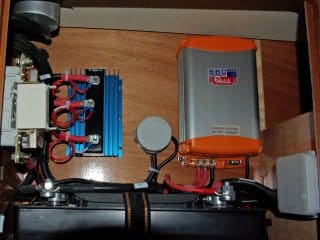
charger over batteryboats_8620.jpg
Last week’s dirty battery post raised a good comment from reader Mike. Basically he was questioning whether the blue case visible at the top of the photo was a battery charger and if so, he was commenting that it is not a good thing. Good eye Mike! You are right, at least based on ABYC Standard A-31 which is pretty clear about mounting battery chargers and other equipment directly over a battery. To quote directly from the standard:
“To avoid corrosive fumes, battery chargers, inverters and inverter/charger shall not be installed directly over batteries.” So besides the photo from last week’s post, here is yet another from my collection:

So, in the above installation, we not only have the battery charger (grey and orange) installed directly over the battery, we have a battery isolator (blue fins) and on the left, a high amp main fuse for the boat’s electrical system. So what’s up you ask?
The truth is the ABYC standard could probably use a little tweaking in the way its worded to better deal with today’s realities in this area.
Historically this was a major no no. But, I contend that it is much less of a concern in today’s world. Why you ask? Its simple, modern batteries are far less prone to “gassing” than their older cousins. There is a long list of technical reasons for this which I’ll probably discuss in a different post, but suffice to say that gassing is really not such a big deal anymore. In the old days, battery gassing while re-charging was more the norm than the exception and this corrosive gas had a way of migrating upward into the innards of any nearby battery charger. The corrosive gasses would gradually destroy the charger from the inside out, often with a default failure mode in the full over-charge mode. This would further contribute to even more gassing as the battery was then being subjected to a severe over-charge situation. All bad stuff.
Well, the good news today is that not only are the batteries themselves less prone to gassing, most are also sealed except for an over pressure relief valve which is often vented outside of the boat and away from the battery compartment altogether. Combine that fact with the fact that many of the chargers available today are actually “potted” and essentially sealed hermetically and we have a situation where the problems of old are virtually gone.
So, from where I sit, I look at this sort of thing on a case by case basis. It depends on the batteries being employed and the type of battery charger in use. Thanks for noticing Mike, it gave me a chance to discuss this matter.
So, Mike responded to my thoughts here right away. His view is quoted right here:
“I do not think the standard needs tweaking in the above case the builder needs to re think its design. While a clean and neat installation, I see lead acid/wet batteries here which do have vents. I see no protective covers on the battery terminals on the isolator or batteries. The strap over the top of the batteries works as a hold-down but is the material able to with stand electrolyte attack?? How about thinking of the 12” dielectric shielding.
All being said careful planning/design are important here most potential boat buyers have no clue and rely on the builder to properly install systems.”
Well Mike, I agree that several things in the photo above fit right into your response. But, what is not totally clear when looking at the photo is that the battery and the components shown are actually inside an enclosed dedicated compartment. None of the components are installed directly **over **the battery either. So, the exposed battery terminals are not too worrisome. But your point about not knowing what a boat owner will replace sealed batteries with in the future is valid. So, perhaps the whole thing could be remedied with a warning label that simply states that a compartment is designed for use with sealed batteries only? Or perhaps, compartment and surrounding are not intended for use with unsealed battery technology….or something to that affect. As for the 12″ dielectric shielding, that applies to metallic fuel lines in ABYC Standard E-10.







